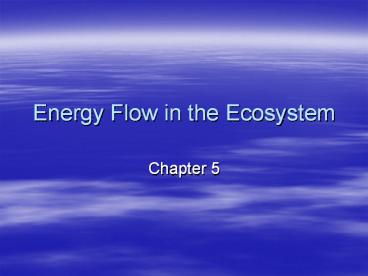Energy Flow in the Ecosystem - PowerPoint PPT Presentation
1 / 26
Title:
Energy Flow in the Ecosystem
Description:
Energy Flow in the Ecosystem Chapter 5 Life Depends of the Sun Energy enters the ecosystem through the process of Photosynthesis. Energy moves from producers to ... – PowerPoint PPT presentation
Number of Views:94
Avg rating:3.0/5.0
Title: Energy Flow in the Ecosystem
1
Energy Flow in the Ecosystem
- Chapter 5
2
Life Depends of the Sun
- Energy enters the ecosystem through the process
of Photosynthesis. - Energy moves from producers to consumers.
3
Life Depends of the Sun
- Producer- Autotroph (self feeder)
- Consumer- Heterotroph (must eat something else to
get energy) - Exception to Rule- Deep Ocean Ecosystems
4
What Eats What
5
Cellular Respiration Burning the Fuel
- Cellular Respiration- process of breaking down
food to obtain energy for growth and daily
functions.
6
Energy Transfer
- Each time one organism eats another energy is
transferred. - We can trace energy transfers through food
chains, food webs, and trophic levels.
7
Energy Transfer
- Food Chain- a sequence of energy transferred from
one organism to another.
8
Energy Transfer
- Food Web- shows many feeding relationships that
are possible in an ecosystem.
9
Energy Transfer
- Trophic Levels- each step in a transfer of energy
through a food chain or food web in an ecosystem.
- Each time energy is transferred from one organism
to another some energy is lost to heat and less
energy is available to the organism at the next
level.
10
Energy Transfer
- Organisms use much of their energy to carry out
life functions like growing new cells, regulating
body temperature, and moving. - About 90 of the energy at each trophic level is
used in this way. The remaining 10 is available
at the next trophic level.
11
Energy Transfer
- Energy Pyramids
12
Biological Magnification
- Biological Magnification- poisons that dissolve
in fat can become more concentrated as the move
up the food chain.
13
The Cycling of Materials
- Carbon Cycle- carbon is an essential component of
proteins, fats, and carbohydrates.
14
Cycling of Materials
- Long terms cycles
- Carbonates- shells, limestone
- Carbon sinks- carbon reserves in the earth
- Fossil Fuels- carbon that what stored in bodies
millions of years ago. - Human affects of the carbon cycle
- When we burn fossil fuels and wood we add Carbon
dioxide to the atmosphere.
15
Cycling of Materials
16
Cycling of Materials
- The Nitrogen Cycle-
- All organisms need nitrogen to build proteins
- 78 of the earths atmosphere is made up of
nitrogen but it is NOT usable by most organisms
in this form. - A few species of bacteria can convert nitrogen
from the atmosphere into a usable compound-
Nitrogen fixing Bacteria
17
Cycling of Materials
18
Cycling of Materials
19
Cycling of Materials
- The Phosphorus Cycle-
20
Cycling of Materials
- Fertilizers
- Fertilizers containing Nitrogen and phosphorus
are added to soil to increase plant growth. - Excess fertilizers can end up in water ways
causing eutrophication (an algal bloom) - Acid Precipitation-
- Burning of coal and other fossil fuels adds
nitric oxide to the atmosphere. When added to
rain water it produces acid rain.
21
How Ecosystems Change
- Ecological Succession- the gradual process of
change and replacement of species in a community. - Primary Succession- the type of succession that
occurs where no ecosystem previously existed. - Ex- new volcanic islands, areas exposed by
glacial retreats, parking lots - Slow process- soil must be formed from broken
down rock. (hundreds to thousands of years to get
fertile soil) - Pioneer species- first species to colonize newly
available area. - Ex.-bacteria and lichens
22
How Ecosystems Change
- Secondary Succession- the type of succession that
occurs where an ecosystem previously existed. - Fire- required for certain ecosystems to be
maintained. - Old field succession- occurs when farm land is
abondoned.
23
How Ecosystems Change
24
How Ecosystems Change
25
How Ecosystems Change
Old- Field Succession
26
How Ecosystems Change
- Climax community- a mature stable community where
the type of ecosystem will remain basically
unchanged unless it is altered.































